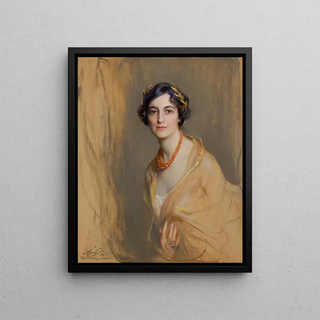Art print | Portrait of Mrs. William Wickham Hoffman née Katherine Miller - Philip Alexius de László


View from behind

Frame (optional)
Portrait of Mrs. William Wickham Hoffman née Katherine Miller - Philip Alexius de László – Captivating Introduction
The "Portrait of Mrs. William Wickham Hoffman née Katherine Miller" by Philip Alexius de László is a work that transcends the simple frame of a painting. It invites the viewer to delve into the intimate universe of its subject, a woman whose grace and elegance are beautifully captured by the artist's brush. This portrait, distinguished by its rich chromatic palette and fine details, is much more than a mere reflection of physical beauty; it evokes an era when portrait art was an essential means of social communication and status. Contemplating this piece, one feels a silent dialogue between the past and the present, an invitation to explore the nuances of aristocratic life in the early 20th century.
Style and uniqueness of the work
László's work is characterized by a style that combines realism and elegance. The artist's painting technique, which relies on plays of light and shadow, brings the canvas to life. The delicacy of Katherine Miller's facial features, as well as the texture of her clothing, testify to immense craftsmanship. The choice of colors, both soft and vibrant, creates a warm and welcoming atmosphere. This portrait is also marked by a thoughtful composition, where the woman's gaze turns toward the viewer, establishing a direct and personal connection. This interaction creates an impression of intimacy, as if inviting the viewer to share a privileged moment with the subject of the painting. The singularity of this work lies not only in its technique but also in the personality it exudes, making Katherine Miller both accessible and mysterious.
The artist and his influence
Philip Alexius de László, born in 1869, is a renowned portraitist whose work has captured the essence of his contemporaries. Trained at the art schools of Budapest and Paris, he developed a distinctive style that allowed him to stand out in the art world. László had the honor of painting many eminent personalities of his time, which attests to his influence and recognition. His approach to portrait

Matte finish

View from behind

Frame (optional)
Portrait of Mrs. William Wickham Hoffman née Katherine Miller - Philip Alexius de László – Captivating Introduction
The "Portrait of Mrs. William Wickham Hoffman née Katherine Miller" by Philip Alexius de László is a work that transcends the simple frame of a painting. It invites the viewer to delve into the intimate universe of its subject, a woman whose grace and elegance are beautifully captured by the artist's brush. This portrait, distinguished by its rich chromatic palette and fine details, is much more than a mere reflection of physical beauty; it evokes an era when portrait art was an essential means of social communication and status. Contemplating this piece, one feels a silent dialogue between the past and the present, an invitation to explore the nuances of aristocratic life in the early 20th century.
Style and uniqueness of the work
László's work is characterized by a style that combines realism and elegance. The artist's painting technique, which relies on plays of light and shadow, brings the canvas to life. The delicacy of Katherine Miller's facial features, as well as the texture of her clothing, testify to immense craftsmanship. The choice of colors, both soft and vibrant, creates a warm and welcoming atmosphere. This portrait is also marked by a thoughtful composition, where the woman's gaze turns toward the viewer, establishing a direct and personal connection. This interaction creates an impression of intimacy, as if inviting the viewer to share a privileged moment with the subject of the painting. The singularity of this work lies not only in its technique but also in the personality it exudes, making Katherine Miller both accessible and mysterious.
The artist and his influence
Philip Alexius de László, born in 1869, is a renowned portraitist whose work has captured the essence of his contemporaries. Trained at the art schools of Budapest and Paris, he developed a distinctive style that allowed him to stand out in the art world. László had the honor of painting many eminent personalities of his time, which attests to his influence and recognition. His approach to portrait






